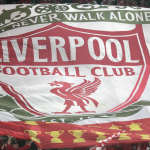
“I may not have gone where I intended to go,” wrote the author Douglas Adams in his 1991 novel The Long Dark Tea-Time of the Soul, “but I think I’ve ended up where I needed to be.”
It’s a sentiment that applies perfectly to Manchester United’s pursuit of a new midfielder this summer. After months of fruitlessly twerking in Frenkie De Jong’s direction, and following a botched last-ditch move for Adrien Rabiot, United have stumbled into solving a decade-old problem – their desperate need for a top-class defensive midfielder – by signing one of the last decade’s finest exponents of the role, Real Madrid’s Casemiro.
The lack of an able shield at the base of United’s middle third has been a recurring issue dating back as far as Sir Alex Ferguson’s 2013 retirement. After the legendary manager stepped down, midfield stalwart Michael Carrick’s inevitable, age-related decline accelerated. The former England playmaker was never quite the same after United’s last title campaign, in the 2012-13 season, with injuries more frequent and his mobility waning.
Attempts were made to replace Carrick in subsequent summer transfer windows, most notably with the arrivals of Bastian Schweinsteiger and Morgan Schneiderlin in the summer of 2015. But the former had past his peak and the latter ultimately struggled to perform at the highest levels.
Nemanja Matic represents United’s best effort to date at plugging their troublesome midfield hole. But the Serbian, who joined Roma as a free agent this summer, was hardly an unqualified success in his five seasons at Old Trafford, unable to consistently reproduce the form of his title-winning Chelsea pomp.
More recently, the maligned “McFred” duo of Brazil international Fred and academy graduate Scott McTominay have been tasked with shielding the backline in a double pivot. The pair have often boasted all the impenetrability of a colander.
So to have now added, in Casemiro, a player who has been crucial to five Champions League triumphs and three La Liga titles, and who has long been considered arguably the best defensive midfielder in the game, is about as monumental an upgrade as possible.
🎙️ “He knows the game, he knows how to win”
Erik ten Hag outlines how important a signing Casemiro is for #MUFC 🔴📝 pic.twitter.com/3emqOFBca3
— Sky Sports Premier League (@SkySportsPL) August 22, 2022
In defeats to Brighton and Brentford in their opening two matches of the 2022-23 Premier League season, United wilted under the pressure and intensity of their opponents’ play. They were rushed and harried into mistake after mistake and were easily played through in the middle of the pitch.
Casemiro, who was introduced to the Old Trafford faithful before United’s impressive 2-1 victory over Liverpool on Monday evening, guards against that.
The Brazilian’s strengths are in his powers of ball recovery. He has made more tackles (589) than any other player in Europe’s top five leagues over the last five seasons. Last term, no current United player could better his rate of 2.8 tackles per 90 minutes, nor his tackle success of 68.2 per cent.
He is also adept enough in possession to not be hounded into coughing up the ball, as many United players were in their first two games of the campaign. Having spent much of his time at the Bernabeu alongside pass masters Toni Kroos and Luka Modric, Casemiro kept his on-ball work simple, utilising short, sharp and safe passes to keep his side’s moves ticking. Nevertheless, he made more passes per 90 last season (68.5) than any current United midfielder, and with a higher success rate (86 per cent).
Yet despite his undeniable calibre and the fact he represents an instant and sizeable upgrade on the club’s current midfield options, United’s signing of Casemiro has been met with no small measure of scepticism.
The doubts stem largely from the players age – 30 – and the cost to United of acquiring him at this stage of his career: an initial £50.7 million to Madrid and a four-year contract that makes him one of the Premier League’s highest-paid players.
But in the realm of topsy-turvy transfer fees – in which Chelsea can pay more for left-back Marc Cucurella than Manchester City spent on Erling Haaland – the sum United have paid for Casemiro, considering his enormous quality and track record of performance at the game’s very highest echelons, hardly seems earth-shattering.
And concerns over his age are misguided. This is not a pace-reliant winger on the cusp of physical decline. Nor a player with an injury history that’d make the cast of Jackass wince. Casemiro has never had a great deal of pace to rely on. His skill is his precise timing of interventions, his near-flawless positioning and, let’s face it, his remarkable ability to skirt the boundary of a second yellow card after already being cautioned. And his injury record is remarkably clean: according to the website transfermarkt.com, he missed just 31 games across all competitions through injury or illness in ten years with Real Madrid.
It is perfectly conceivable, then, that Casemiro will remain one of Europe’s most effective defensive midfielders well into his mid-30s.
“He is the cement between the stones,” United manager Erik Ten Hag enthused to Sky Sports of his new signing. “That is what we have been looking for in the summer and found him.”
That they spent much of the transfer window – much of the last decade – looking in the wrong places will be forgiven if Casemiro is a success.



